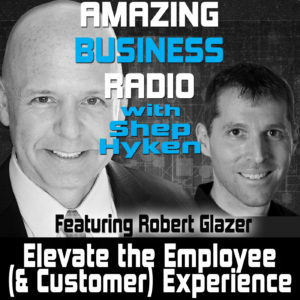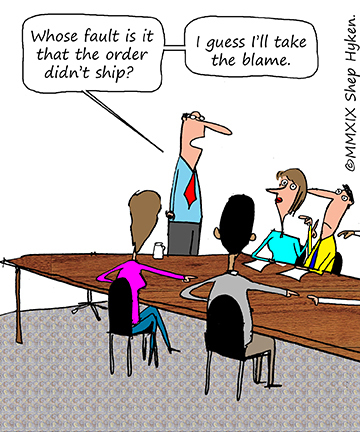Shep Hyken's Blog, page 115
December 3, 2019
Amazing Business Radio: Robert Glazer
 Elevate the Employee (and Customer) Experience
Elevate the Employee (and Customer) ExperienceMaking a Lasting Impact on the People That Power Your Business
Shep Hyken interviews Robert Glazer. They discuss his practice of employee “wish-granting,” common service mistakes businesses make and his book, Elevate: Push Beyond Your Limits and Unlock Success in Yourself and Others.








Top Takeaways:
Find ways to do something meaningful for your employees around the holidays—or any time of year. Experiences often are better remembered and make a bigger impact than money.
By investing in your employees, you are investing in the culture of your organization. With a strong culture, you will attract and keep the kind of employees you want.
Customers will not love your company until your employees love your company. Focus your efforts on the employee experience and the customer experience will follow.
“Capacity building” is the method by which individuals seek, acquire, and develop the skills and ability to consistently perform at a high level in pursuit of their innate potential.
The four elements of capacity building are spiritual, intellectual, physical, and emotional. Focus on each of these elements individually and you will improve your entire being.
“Spiritual” does not necessarily mean religious. In business, it’s about knowing who you are, what you want, and the standards by which you want to live each day. This is crucial to be a successful leader.
Three common service mistakes even top businesses make are not establishing rapport with customers, over-responding to a single piece of feedback, and not offering customers full explanations.
You don’t have to tackle 100% of change all at once. Tackle 1% every day, and soon you will see it add up into big, positive change.
To sign up for Robert Glazer’s weekly newsletter that inspired his book, go to http://www.fridayfwd.com.
Quotes:
“If you really want to impress people, listen to them. You will be amazed by how much they appreciate that.” – Robert Glazer
“It only takes a few seconds to ask someone how their day is going.” – Robert Glazer
“Make the 1% improvement. If you do 1% each day, it adds up pretty quickly and soon you’ll see big change.” – Robert Glazer
About:
Robert Glazer is the founder and CEO of Acceleration Partners. He is a serial entrepreneur and author of Elevate: Push Beyond Your Limits and Unlock Success in Yourself and Others.
Shep Hyken is a customer service and experience expert, New York Times bestselling author, award-winning keynote speaker, and your host of Amazing Business Radio.
This episode of Amazing Business Radio with Shep Hyken answers the following questions … and more:
What is the secret to a good employee experience?
How does the employee experience affect the customer experience?
What are the top 3 customer service mistakes businesses make?
What should I get my employees for the holidays?
How can I build my company culture?
The post Amazing Business Radio: Robert Glazer appeared first on Shep Hyken.
December 2, 2019
5 Top Customer Service Articles for the Week of December 2, 2019
Each week I read a number of customer service and customer experience articles from various resources. Here are my top five picks from last week. I have added my comment about each article and would like to hear what you think too.
Top 10 Kudos of 2019: Shining Examples of Customer Service at Its Best by Patty Isnor
(Blue Ocean) As the holiday season unfolds, we wanted to share the amazing words of gratitude that flow every day from our clients’ customers to our agents. In this article, you will find the best customer service kudos of 2019 (so far!) with quotes directly from the mouths of customers we interact with.
My Comment: This is as much of an idea as it is an article. This company took the “Top Ten Kudos” it received from customers they interact with and shared it with not only employees but the entire world. A great way to motivate the people you work with as well as get customers excited about doing business with you!
Customer Service Déjà Vu [Infographic] by ServiceNow
(Forbes) 10 mind-blowing stats on why today’s customer service looks a lot like yesterday’s.
My Comment: I love good stats and facts, and this infographic shared in Forbes is exactly the kind of information that gets me excited. “Mind-blowing” is a pretty powerful phrase to describe most stats. Worst case, they will give you something to talk about, and for some of you reading, will make you want to take action.
How To Build A Customer-Centric Culture Through Employee Appreciation (10 Tips) by Stacy Sherman
(Thrive Global) It’s no secret that happy employees yield better business results. There’s a lot of research indicating customer satisfaction and loyalty rises when employees enjoy their jobs and workplace.
My Comment: The secret to having happy customers is having happy employees. This is a wonderful list of simple things you can do to create a customer-focused culture, and that starts with the way employees are treated. If you’ve been following my work, you know that one of my favorite sayings is, “What is happening on the inside of the organization is felt on the outside by the customer.”
The Top 10 Technology Trends In Retail: How Tech Will Transform Shopping In 2020 by Bernard Marr
(Forbes) Technology is changing the way every industry does business by helping to create efficiencies, save money, and provide better products and services. Retail businesses are also adopting technology to their advantage. Here are 10 of the top tech trends that will transform shopping.
My Comment: The focus of this article is on retail, but there are a few technology predictions that apply to almost any industry. Consider data, stock/inventory management, customer care and the Internet of Things (IoT). You’ll find some insightful thoughts that you may want to consider in the near future.
How Would You Rate Your Company’s Client Experience? 3 Tips For Success by Teresa Becker
(Business 2 Community) Client experience, otherwise known as CX, is something you will hear often as you determine how to design and implement your product solutions for your clients. A positive client experience is crucial for long-term (and even short-term) success. In simple terms, the client experience is the interaction a person has with an organization and/or their product or service.
My Comment: Want to help ensure your client’s success? Consider the three ideas in this article, which focus on training customers on how to best work with you and use your products, getting your customer’s feedback, and building a customer-focused culture. Three “basics” that are worth being reminded of (over and over).
 Shep Hyken is a customer service expert, professional speaker and New York Times bestselling business author. For information on The Customer Focus
Shep Hyken is a customer service expert, professional speaker and New York Times bestselling business author. For information on The Customer Focus customer service training programs go to www.TheCustomerFocus.com. Follow on Twitter: @Hyken
customer service training programs go to www.TheCustomerFocus.com. Follow on Twitter: @Hyken
The post 5 Top Customer Service Articles for the Week of December 2, 2019 appeared first on Shep Hyken.
November 29, 2019
Guest Blog: 5 Ways To Leverage Technology For A Better Customer Experience
This week we feature an article by Rahul Varshneya who writes about how technology innovations are continuously improving the customer experience.
“People will forget what you said, people will forget what you did, but people will never forget how you made them feel.” This Maya Angelou quote fits perfectly when talking about the factors responsible for positive brand customer service.
Support experience, overall experience, company culture, quality of product/service, are the major factors that decide how your brand makes the customer feel. And as humans, we use emotions in daily life to make all sorts of decisions. It’s natural for emotions, then, to be a natural part of customer engagement and experience.
So, what part does technology play in this? Technology (or the ease of access to it) opens up options for people; they can take their business anywhere they want.
According to a Salesforce’s connected shopper report, 79 percent of shoppers research a brand online before making a purchase in the store. Also, 45 percent of customers use email to connect with customer service. Customer service, therefore, extends beyond just the post-purchase cycle; pre-purchase and in-store experiences matter to modern customers.
As we will see in the next section, technology is already helping businesses reach their customers faster and provide a delightful experience. This is leading to increased brand loyalty as customers experience repeated positive interactions with the brand.
How to leverage technology for a better customer experience
There has been an outburst of technology in the past decade in every area of human life. From talking bathroom mirrors (thanks to Kohler) to reusable rockets (courtesy of SpaceX), we have seen unprecedented, often bewildering innovation.
Customer experience has not been left behind.
1. Use social media as a forefront of customer service
Before Mark Zuckerberg revolutionized online communication with Facebook, the pace of feedback traveling via word-of-mouth was slow. Brands could contain negative experiences by addressing them on a one-by-one basis.
Social media has empowered users to share instant feedback with their followers – and have those comments validated instantly. There is no place to hide for brands that don’t realize the value of customer service.
As social networks open up new avenues for company reviews, companies have adopted their workflows to address their concerns at the point of origin. By using social accounts for addressing all kinds of customer queries, companies are expanding their customer experience strategy.
This effect is more pronounced than ever. CRM tools are increasingly incorporating social media into their customer support modules. This allows support teams seamless access to customer information and complaints on the same platform.
Brands like Starbucks use their parent Twitter account to address complaints and generally talk to customers. Netflix has a dedicated Twitter account called NetflixHelps to respond to customer complaints. Nike does the same with its TeamNike account.
2. Own your customer experience with a custom-developed app
Users can consume your products/services without a browser, talk to a customer service agent, use your app during product research, and much more. Combine offline content and functionalities and the customer experience increases manifold.
Give users goals (based on feature usage in the app) and reward them for completing these goals. This adds gamification to the customer experience mix and it could very well make your app viral. And you know what that means? More brand recognition, more leads, and more customers.
The mobile app experience seamlessly integrates with pioneering technologies like artificial intelligence, augmented and virtual reality and big data analytics to offer engaging experiences. Creating a mobile app ensures that customers are connected to your brand at all times, irrespective of their physical location.
Customer engagement isn’t just limited to remote experiences. With rising mobile usability and preferences, brands such as Walmart are leveraging mobile apps to leverage in-store retail experiences as well. Mobile apps bridge the gap between online and offline brand interactions and provide a vital window of opportunity by providing round the clock customer engagement.
However, don’t just start creating an app just because everyone else is doing it. When it comes to successful apps, there is a method to the madness. Often when companies think of their first mobile app, they fail to go through one of the primary phases of careful planning, verification, and validation of the app idea. A poorly planned app could wreck your brand instead of lifting it up.
3. Message bots to enable round-the-clock, multi-purpose customer service
Bots are probably the most versatile technology being used in modern customer service teams. They are useful when the customer service team is not available. Bots can enable automation to the extent of self-service (for basic queries/complaints) for the customers. Amazon is using bots for quick queries and complaint resolution.
With pre-configured messages and conditional sequence logic programmed into the bot, you can delight new customers on Facebook messenger and create a great first impression.
Michael Kors Concierge (the company’s Shorty Award-winning Facebook Messenger bot) boats of a mind-blowing array of features creating an exquisite experience for its customers. And it has impressive stats to boast:
375,000 total active users and an average of 45,000 new users per month since its launch.
More than 98% of customers contacting the chatbot stay within the bot. Only less than 2% of its customers are directed to a customer service agent
Social media bots can also be used as a supplemental channel for content marketing as well, drawing more traffic to your online assets and engaging customers on their platform of choice.
4. Virtual Reality (VR) and Augmented Reality (AR) to make immersive, 3D experiences possible
VR and AR have opened up a brand new avenue for brands to offer a truly immersive experience. While VR provides an immersive 3D display, AR projects 3D images onto live video allowing customers to get an idea of the final picture before it is even built.
One of the more common applications of AR is an AR-enabled manual app that replaces the bulky paper manual. It sets a new standard for how users experience machines. Hyundai has done this by helping customers understand its car dashboards with an app.
Product testing is another area where AR/VR provides a tremendous positive customer experience.
On the IKEA Place app (iOS), Customers just have to select a product and the app uses AR to show them how it would look like in their home. There is instant feedback that delights the customer because it is an innovative and novel experience for them. It also saves their time as they can visualize products they want to buy right in their homes.
Certain Audi dealerships also allow users to configure their own vehicles and then use VR to test their vehicles in the store without taking a test drive. Customers get to experience a sense of ownership for the vehicle because they were involved in selecting it.
5. A better understanding of the customer with predictive analysis using AI and BigData
Predictive analysis with AI involves predicting a user’s behavior and their needs based on the patterns mined from their past behavior and order history. It provides insights into customer behavior and is a particularly favored method of analysis in eCommerce.
It allows brands to understand their customers’ needs, motivations, and personalities and then use this data to serve them content specifically for them. By serving personalized product suggestions, you can increase the relevance of your brand with visitors.
By analyzing your own sales data, you can predict the needs of users and use it to optimize your supply chain. This way you can ensure the availability of products as and when the users need it. If you get people what they want when they want it, you set yourself up for more customer loyalty and word-of-mouth marketing.
Apart from personalized suggestions, predictive analytics tools like TIBCO Spotfire and Microsoft Azure ML studio use personalization for marketing on multiple channels.
For example, if you know a user likes one of your products, you can use retargeting to serve them ads.
It also enables personalized content delivery through email and landing pages. As customer relates to these types of content, the trust factor increases and it leads to more micro-goals being fulfilled.
Final Words
As technology penetrates every walk of human life, customer experience teams have all the more opportunities to delight the customers. In fact, customer experience is now becoming a competitive factor among businesses. In an effort to stay ahead of the competitors, we will see new innovations in technologies that allow brands to drastically reshape how customers perceive them.
There are many paths ahead. Which one are you most excited about?
Rahul Varshneya is the co-founder and President of Arkenea. Rahul has been featured as a technology thought leader in numerous media channels such as Bloomberg TV, Forbes, HuffPost, Inc, among others.
For more articles from Shep Hyken and his guest contributors go to customerserviceblog.com.

Read Shep’s latest Forbes article:
The post Guest Blog: 5 Ways To Leverage Technology For A Better Customer Experience appeared first on Shep Hyken.
November 27, 2019
When Things Aren’t Going Well, Will You Accept Blame?
 In a recent Shepard Letter, I wrote about the concept of giving recognition to the people who deserve it. Someone being recognized for what they bring to the organization is often overlooked. That’s a shame. People need to be recognized for their contribution to the team’s success. One of our faithful readers, Drew Smith, responded to the article and shared that he was reading a biography about the 34th President of the United States, Dwight Eisenhower, who was known for “pushing praise down and blame up—to himself.”
In a recent Shepard Letter, I wrote about the concept of giving recognition to the people who deserve it. Someone being recognized for what they bring to the organization is often overlooked. That’s a shame. People need to be recognized for their contribution to the team’s success. One of our faithful readers, Drew Smith, responded to the article and shared that he was reading a biography about the 34th President of the United States, Dwight Eisenhower, who was known for “pushing praise down and blame up—to himself.”
This is an interesting concept. The idea of praising people for the good job they do is powerful. It’s quite easy and comfortable to share praise, but what about the concept of blame? For most, that is a difficult topic. But Eisenhower was willing to take the blame, even for something that could be considered out of his control. There is a famous speech he never gave. It had to do with the invasion of Normandy in World War II. He believed that based on the information he had from his team of experts that the invasion would be successful. Even so, he prepared his speech on the chance the effort would fail, and it ended with the closing line, “If any blame or fault attaches to the attempt it is mine alone.”
Consider that the 33rd President of the United States—Eisenhower’s immediate predecessor—was Harry S. Truman, who had a sign on his desk that read, “The buck stops here!” He referred to this sign in a number of his speeches. Its meaning was about accepting personal responsibility for the way he ran the country. He wasn’t going to “pass the buck,” or blame anyone else for his failures.
Do you see a trend here? As I look at successful people, I notice something they have in common. They are quick to praise and recognize others—and just as quick to accept blame for failure. By the term “successful,” I’m not just referring to presidents of countries or leaders of large companies. No, success isn’t just defined by a title. My friend, Mark Sanborn, wrote a book entitled You Don’t Need a Title to Be a Leader: How Anyone, Anywhere, Can Make a Positive Difference. The title of that book sums it up nicely. It doesn’t matter what you do, you just have to act like a leader. It’s behavioral. Recognizing others who are successful is the act of a leader. Accepting responsibility (and blame) for something that happened under your watch is also powerful leadership behavior.
It’s never fun or easy when something doesn’t go the way you planned. What’s even more difficult is taking responsibility for it, and beyond that, admitting you were wrong. But, as I said, it’s crucial to moving forward. Don’t be the person who “passes the buck” when mistakes are made. Instead, emulate the leadership behavior of Eisenhower and Truman. Even though you may never be President of the United States or even have the job title of “leader” within your own organization, you can still set the example of what makes a good leader by giving praise and owning blame.
Shep Hyken is a customer service expert, keynote speaker, and New York Times bestselling business author. For information, contact 314-692-2200 or www.hyken.com. For information on The Customer Focus customer service training programs, go to www.thecustomerfocus.com. Follow on Twitter: @Hyken
customer service training programs, go to www.thecustomerfocus.com. Follow on Twitter: @Hyken
(Copyright © MMXIX, Shep Hyken)
The post When Things Aren’t Going Well, Will You Accept Blame? appeared first on Shep Hyken.
November 26, 2019
Amazing Business Radio: Alyona Medelyan
 Get Thematic with Customer Feedback
Get Thematic with Customer Feedback How to Get the Most Out of Your Customer Feedback
Shep Hyken interviews Alyona Medelyan. They discuss how natural language processing can help companies focus on the most important problems to drive up customer satisfaction. Sound a little technical? It is, but it’s fascinating. More important, it’s relevant. The future is here today!








Top Takeaways:
Natural language processing is an analytic tool that helps programs and AI (artificial intelligence) analyze and understand “everyday” language.
Using natural language processing allows companies to understand what customers are saying in their own words, link it to NPS (Net Promotor Score) and, most importantly, identify the most important problems their customers are facing.
Once companies have identified the problems that are most important to their customers, they can prioritize the order in which they fix them. Too often executives focus on things that matter less to customers rather than fixing the most pressing issues.
More often than not, customer service is not the root of the problem. Broken processes are often the culprit for low NPS scores, while good customer service is the only thing that keeps those scores above 0.
Surveys, in general, should be kept on the short side. However, they can be a little longer if you allow your customers to opt-out of them and also offer them a way to share their thoughts and opinions freely.
Above all, the most important thing is for companies to give customers the chance to explain what they like and don’t like in their own words. Open the channels of communication a little wider and you will reap the rewards.
Quotes:
“If you are running a business, think about how you get feedback from customers. Make sure you let customers explain in their own words what matters to them.” – Alyona Medelyan
“You can use feedback to actually make a difference to both customer experience and your revenue.” – Alyona Medelyan
About:
Alyona Medelyan, Ph.D. is CEO & co-founder of Thematic, a customer insights solution that uses the power of AI & machine learning to analyze customer feedback. She has completed 15 years of research in natural language processing & machine learning.
Shep Hyken is a customer service and experience expert, New York Times bestselling author, award-winning keynote speaker, and your host of Amazing Business Radio.
This episode of Amazing Business Radio with Shep Hyken answers the following questions … and more:
What is natural language processing?
How can I make better use of customer feedback?
How can I better understand my customers?
How can analytics and data tools improve my customer service?
How can I get a better NPS score?
The post Amazing Business Radio: Alyona Medelyan appeared first on Shep Hyken.
November 25, 2019
5 Top Customer Service Articles for the Week of November 25, 2019
Each week I read a number of customer service and customer experience articles from various resources. Here are my top five picks from last week. I have added my comment about each article and would like to hear what you think too.
The Jury Is in on the Future of Customer Experience by Lisa Loftis
(CMSWire) Trends that if recognized and acted upon, can help companies shape their digital experience strategies for a decade to come.
My Comment: What does customer experience (CX) look like a year from now? How about ten years from now? The author of this article shares her observations based on trends, not guesses, about the future of CX. Something that is a hot topic today, and will only become more important is privacy. It builds trust, and handled improperly, can erode it (quickly). Good insights on several trends that are leading us forward.
What Is Customer Experience? by Mariana Henriques
(Outsystems) CX refers to the ongoing relationship between a customer and your company. Ultimately, CX is about the perception and emotion that a customer is left with after interacting with your brand. And because nowadays these interactions happen across multiple channels and touchpoints, CX ends up being the sum of those interactions and the lasting impression they leave with them.
My Comment: This excellent article answers the question, “What is customer experience?” There is plenty of info, stats and facts that will take you from the author’s definition to strategic and tactical ideas that will help shape and improve your organization’s CX.
How Bad Customer Service Affects Your Business by Mansi Bhatia
(Ameyo) There are no questions that customer service is an integral component of any business’s success. You might have an awesome product and great pricing but if your customer’s experience is not good, then you are losing the ultimate battle to win their hearts.
My Comment: Consider this: According to a recent Microsoft studies, 54 % of customers have higher expectations for customer service than in previous years. And, if you look at the younger consumers, aged 18-34, that number jumps to 66%. Great brands are teaching all customers what it is like to receive great customer service, and customers now expect – if not demand – that from all the companies they do business with.
How To Build A Winning Customer Service Culture In Your Company by Krishna Charan
(Freshdesk) While workplace culture is more organization and employee-oriented, service culture puts customers at the forefront of every business goal, organizational vision, and support outcome.
My Comment: If you want to deliver great service and a great customer experience, it has to start on the inside of the company. I’ve often said that customer service is not a department, but a philosophy to be embraced by all employees of an organization. In other words, it’s built into the culture. This excellent article focuses on exactly that; what it takes to build a customer service culture.
15 Marketing Strategy Tips To Improve Your Customer Experience by Expert Panel, Forbes Communications Council
(Forbes) Fifteen associates of Forbes Communications Council offer advice on what businesses that want to focus on enhancing their customer experience should implement or improve.
My Comment: Here is an excellent list compiled by the Forbes Communication Council. You’re sure to find something of value here. Fifteen council members who have “in the trenches” experience share their ideas on how to enhance an organization’s customer experience.
 Shep Hyken is a customer service expert, professional speaker and New York Times bestselling business author. For information on The Customer Focus
Shep Hyken is a customer service expert, professional speaker and New York Times bestselling business author. For information on The Customer Focus customer service training programs go to www.TheCustomerFocus.com. Follow on Twitter: @Hyken
customer service training programs go to www.TheCustomerFocus.com. Follow on Twitter: @Hyken
The post 5 Top Customer Service Articles for the Week of November 25, 2019 appeared first on Shep Hyken.
November 22, 2019
Guest Blog: The Hidden Workings of Top Customer Support Teams
This week we feature an article by Robert Occanyan who shares what successful customer support teams are doing to deliver an exceptional customer experience.
Here’s an important fact that customer support teams should always remember—people are more likely to remember negative experiences over positive ones. In fact, according to an article published in The Washington Post, “[…]in general, we tend to notice the negative more than the positive.”
This puts a lot of extra pressure on businesses to deliver exceptional customer service. It’s not enough to have a great product—that product also has to come with great customer experience. There’s very little room for error given that “it will take 12 positive experiences to redeem one unresolved negative experience among customers.”
Given all this, it certainly seems like customer support teams have their work cut out for them. However, while it seems challenging, it’s definitely not impossible. A lot of companies around the world have demonstrated their ability to go the extra mile for their customers. It all boils down to understanding the principles that differentiate a good support team from a great one.
Now, the question is, what could these principles be? For businesses that have become the benchmark for top customer service, what are they doing differently? Consider the following:
1. They go over and above to provide excellent customer service
Today, a brand or service’s ability to deliver excellent customer service is a badge of honor. Businesses are proud of the fact that their teams know how to address and prioritize customer needs. They’re also more than happy to share and publicize their accomplishments. As a result, customers today are more educated about what great customer service is. They know they don’t have to settle for a sub-standard, or even average, customer experience; and this is why it’s so important to go above and beyond what is expected of you.
Online retailer Zappos is a great example. Consistently voted as one of the top brands that can deliver a one-of-a-kind customer experience, the brand refers to itself as “a service company that happens to sell shoes, handbags, and more.” This philosophy highlights that they’re more than just a business that wants to sell; they’re a business that puts their customers first.
2. They use the right words and tone when communicating
Top customer support teams know how to build rapport and empathy with the customer. They do this expertly by using the right words and tone when speaking to them. They know the weight that their choice of words carries.
For example, when a customer is making an inquiry about a specific product that is unavailable, an expert customer support representative will do more than just tell the customer it’s unavailable. The customer will likely receive an apology, then be informed that the product is in high demand and that they would love to put the customer on the priority list to receive the product as soon as possible. This way, the rep is able to communicate accurately without putting off the client and making them feel like their needs won’t be addressed.
3. They consistently deliver and exceed customer expectations
Customers already expect their needs to be addressed with every interaction they have with your company. That’s the baseline that all customer support teams should already be working on. Therefore, your goal should be to make sure that you’re able to cater to their concerns efficiently and exceed customer expectations, and do so every single time.
Consistency is the key to great customer service. It’s how top customer support teams can build trust and loyalty among customers.
4. They focus on building a relationship over finalizing a transaction
Great customer support teams know that their interactions with customers go well beyond their ability to handle a query. They focus on the fact that trust is essential to the whole customer service experience and take the necessary steps to build the kind of rapport that will keep customers coming back to them.
How? By being proactive about the position they have to solve a customer’s problem; by empathizing with the customer’s frustration and clearly guiding them through the next steps; by regularly contacting and updating customers until their concerns are resolved.
5. They find and implement the right tools to facilitate better operations
Technology today gives customer service teams a lot of options to help them assist and manage customer needs better. Great customer service teams know what tools they can utilize to improve customer care. Some examples include platforms that offer multi-channel support to make it easier for customers to reach out to the business at the speed of need; or communication solutions that ensure better reliability. They also look into tools that can help gather useful analytics and track metrics. This way, they can use real data to improve operations and internal processes.
Bottom line…
Customer support has largely been seen as an industry that requires teams to be reactive. And in a way, it’s true. However, to deliver exceptional service, they have to do more than just reacting to concerns as they come. These points are what sets the top customer teams apart from the average ones.
With marketing and advertising to attract new customers being one of the biggest challenges facing small businesses today, it’s more important than ever to retain existing customers by delivering exceptional customer service.
If you want your business to stand out, it’s time you incorporate these insights into how you do business.
Robert Oscanyan is a Product Marketing Manager at Jive Communications by LogMeIn, a hosted VoIP provider that helps thousands of organizations simplify how they manage their phone and conferencing systems. Rob spends his time creating new adventures with his wife, six kids, and rambunctious dog while still finding time to binge on crime podcasts. You can find him on LinkedIn.
For more articles from Shep Hyken and his guest contributors go to customerserviceblog.com.

Read Shep’s latest Forbes article: 6 Tips For Small Business Saturday
The post Guest Blog: The Hidden Workings of Top Customer Support Teams appeared first on Shep Hyken.
November 20, 2019
A Dramatic Change Doesn’t Have to Be a Traumatic Change
 The word dramatic is a great word. When you use it to describe changes you make to improve customer service, it has a positive meaning. It sounds like you’re making big changes for the better. However, if you shorten the word to drama, it takes on an entirely different meaning—one that’s negative. Merriam-Webster’s definition for how the word is used in this context is that it is “a state, situation, or series of events involving interesting or intense conflict of forces.”
The word dramatic is a great word. When you use it to describe changes you make to improve customer service, it has a positive meaning. It sounds like you’re making big changes for the better. However, if you shorten the word to drama, it takes on an entirely different meaning—one that’s negative. Merriam-Webster’s definition for how the word is used in this context is that it is “a state, situation, or series of events involving interesting or intense conflict of forces.”
So, make dramatic changes, but don’t let them cause any drama. That drama could turn your dramatically positive experience into a traumatically bad experience.
What got me thinking about this was a recent conversation with Antony Brydon, the CEO and co-founder of Directly, a support automation company. We were talking about how sometimes a company will make a change that dramatically—in a negative way—impacts the customer. Specifically, he mentioned that as Artificial Intelligence (AI) started to take hold, as cool as it was for the company, it wasn’t yet a great experience for the customer. Customers paid the price for companies trying out their new technology. Brydon mentioned the drama that it caused, which prompted my response and the title of this article: a dramatic change doesn’t have to be a traumatic change.
So back to the idea that drama could turn the positive experience into a traumatically bad experience. That word traumatic can be a little concerning. Going back to the dictionary, Merriam-Webster’s definition of the word traumatic is “psychologically or emotionally stressful in a way that can lead to serious mental and emotional problems.” Ouch! A broader definition and one that is much softer is that it is something that causes distress or anxiety. Regardless of the definition, trauma is not something you want your customers to experience.
This is all about being customer-focused. Whenever you make any kind of change to your product, process, price—anything—you must ask yourself, “How is this going to impact the customer?” The answer may be positive or negative, but when you ask that question and get an honest response, you are at least aware of the benefits and pitfalls of the change. If a negative outcome is likely, one so severe that it could cause drama or even trauma, you may want to consider alternatives.
Change can be good. It is often needed to update systems and processes that are outdated or inefficient. This can lead to a better customer—and employee—experience overall. One thing is certain—change is inevitable. Just remember, if you need to make a change that is dramatic, take steps to ensure that it won’t end up being traumatic for your customers.
Shep Hyken is a customer service expert, keynote speaker, and New York Times bestselling business author. For information, contact 314-692-2200 or www.hyken.com. For information on The Customer Focus customer service training programs, go to www.thecustomerfocus.com. Follow on Twitter: @Hyken
customer service training programs, go to www.thecustomerfocus.com. Follow on Twitter: @Hyken
(Copyright © MMXIX, Shep Hyken)
The post A Dramatic Change Doesn’t Have to Be a Traumatic Change appeared first on Shep Hyken.
November 19, 2019
Amazing Business Radio: Antony Brydon
 Will AI Kill the Customer Support Agent?
Will AI Kill the Customer Support Agent?How Humans and Technology Can Support Each Other for the Best Customer Experience
Shep Hyken interviews Antony Brydon. They discuss the role of automation in customer service, and how companies can best use it to improve their customers’ experience.








Top Takeaways:
When companies switch to AI and other new automation technologies, more often than not it is the customers who suffer. Companies must make this switch without sacrificing the customer experience.
AI has the capacity to transform practically every job within the knowledge sector, especially customer service jobs. The key is making it work.
The shortcomings of AI include understanding customer intent and using creativity to solve problems. These are areas where people excel. Integrating the human touch into automated systems will allow the AI experience to improve dramatically.
Rather than AI supporting humans, humans must support and train AI so it gets better. Connecting automation to a network of human subject matter experts is a good way to start.
Technology is changing incredibly fast, so adaptability is key. Humans are good at adapting to new situations and can therefore help automated systems adapt to best serve the customer.
The future is conversational, meaning customers are choosing to connect with companies through more casual conversational channels like texting and instant messaging. AI needs to adapt to this.
Poor automated systems end up costing far more than efficient ones. The more a company invests in automation and AI, the better the experience will be all around.
Don’t associate automation with a poor customer experience. Contrary to popular belief, it is very possible to switch to AI and automated processes that improve the customer experience at the same time.
Quotes:
“So much of a good experience comes down to the investment in that experience.” – Antony Brydon
“Companies need to find a way to implement new technology without leaving the customers behind.” – Antony Brydon
“It is possible to use automation and improve the customer experience at the same time.” – Antony Brydon
About:
Antony Brydon is the CEO and co-founder of Directly, a customer support automation company. Previously, he was the acting CEO for ShopWell, a partner at Social Venture Partners, CEO and co-founder of Visible Path, and CEO and marketing lead for IUMA.
Shep Hyken is a customer service and experience expert, New York Times bestselling author, award-winning keynote speaker, and your host of Amazing Business Radio.
This episode of Amazing Business Radio with Shep Hyken answers the following questions … and more:
How does automation and AI fit into the customer experience?
How can I use AI to improve my CX?
How can humans and AI support each other?
Will AI replace customer support agents?
What is the future of CX?
The post Amazing Business Radio: Antony Brydon appeared first on Shep Hyken.
November 18, 2019
5 Top Customer Service Articles for the Week of November 18, 2019
Each week I read a number of customer service and customer experience articles from various resources. Here are my top five picks from last week. I have added my comment about each article and would like to hear what you think too.
Consumers And Brands Disagree On Customer Experience, Poll Finds by Ray Schultz
(MediaPost) Consumers and brands are on a collision course over what makes a good customer experience.
My Comment: Are you ready for a reality check? Ask marketers (as in brands) if they think they are doing a good job of delivering a good CX, and 82% say they are, however only 10% of customers strongly agree. That stat and more are what you’ll find in this very short, but interesting article.
Set customer service agents up for success as Black Friday approaches by Paul Selby
(CustomerThink) Friday, November 29th is quickly approaching. While many companies may feel ready, take a moment to review these tips for how to take some strain off customer service agents and make the holiday period less stressful for all.
My Comment: How do you set your support center up for success when the influx of calls takes place during Black Friday, Cyber Monday, or any other busy time, for that matter? Here’s the answer. Paul Selby from ServiceNow shares eight tips to help you do exactly that.
The Speed Wars: How Amazon, Target and Walmart Are Competing for Faster Delivery Times by Michael Begg
(B2Community) eCommerce competition seems to be largely driven on one point now – at least the platforms seem to think so. Delivery times have been dropping rapidly over the past year as each major retailer and eCommerce platform attempts to provide better convenience to the end customer.
My Comment: Speedy delivery is something we are growing accustomed to. It’s become an expectation. We are in the midst of a speedy delivery war between three of the largest retailers – Amazon, Target and Walmart – and the winner is… (my opinion) the customer.
How do you make customers feel? by Denise Lee Yohn
(SmartBrief) How you make customers feel often influences them far more than you might realize.
My Comment: How do you make your customers feel? Making customers feel good influences more than you might think. People are drawn to brands that can connect with them on an emotional level. It helps build trust and confidence, and that could lead to more business.
The 3 Golden Rules of Customer Experience by Mazen Ghalayini
(CMSwire) Everyone has a different approach to what works and why when it comes to the nuances of customer experience (CX), but the foundation boils down to: human-centered design, data-driven insights, and value creation. These pillars are paramount to getting the necessary support, ensuring effective execution, and delivering value to your stakeholders and business.
My Comment: These “rules” are golden – or at least worth considering. A short, but good list to drive a better CX; human-centered design, data-driven insights and value creation. I’d pay attention to close attention to the first one, human-centered design. Start by asking the question, “Who is consuming the experience you want to create?”
 Shep Hyken is a customer service expert, professional speaker and New York Times bestselling business author. For information on The Customer Focus
Shep Hyken is a customer service expert, professional speaker and New York Times bestselling business author. For information on The Customer Focus customer service training programs go to www.TheCustomerFocus.com. Follow on Twitter: @Hyken
customer service training programs go to www.TheCustomerFocus.com. Follow on Twitter: @Hyken
The post 5 Top Customer Service Articles for the Week of November 18, 2019 appeared first on Shep Hyken.




